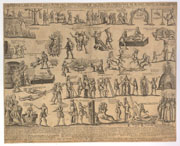Book illustrations
 Printed pictures featured
prominently in books of the period, ranging from simple woodblock scenes and diagrams to
series of engraved plates. Woodcuts had various advantages over engraved images as far as
book illustration was concerned, not least that they could be printed in the middle of a
typeset page; in addition, woodcuts could be reused far more times than engravings. The
earliest woodcut illustrations include those in William Caxton’s edition of Chaucer’s Canterbury Tales of 1483 and woodcuts continued to be used for cheap
publications throughout our period.
Printed pictures featured
prominently in books of the period, ranging from simple woodblock scenes and diagrams to
series of engraved plates. Woodcuts had various advantages over engraved images as far as
book illustration was concerned, not least that they could be printed in the middle of a
typeset page; in addition, woodcuts could be reused far more times than engravings. The
earliest woodcut illustrations include those in William Caxton’s edition of Chaucer’s Canterbury Tales of 1483 and woodcuts continued to be used for cheap
publications throughout our period.
By contrast, engraved images had to be printed separately on a different press, but these, too, became increasingly prevalent during the period following the pioneering efforts of Thomas Geminus in the 1540s. By the 1630s we find series of engraved plates being produced for works like Ovid’s Metamorphoses, and such series of plates became increasingly common as the century progressed, in works such as the editions of Aesop, Homer and Virgil produced by John Ogilby. There were also scientific book illustrations, perhaps the classic specimen being Robert Hooke’s Micrographia (1665), in which he divulged the findings of the microscope to the English public in a lavish and spectacular way.
Also notable are antiquarian book illustrations like those produced by Hollar and others for Sir William Dugdale, both his Monasticon Anglicanum and his History of St Paul’s Cathedral. The former were also issued separately in 1656 by the engraver, Daniel King, as a volume of plates of English cathedrals. From the 1670s and 1680s we have a series of illustrations to David Loggan’s lavish Oxonia Illustrata (1675), and its sequel Cantabrigia Illustrata, which appeared in 1690. Further such works were to follow in the years around 1700.